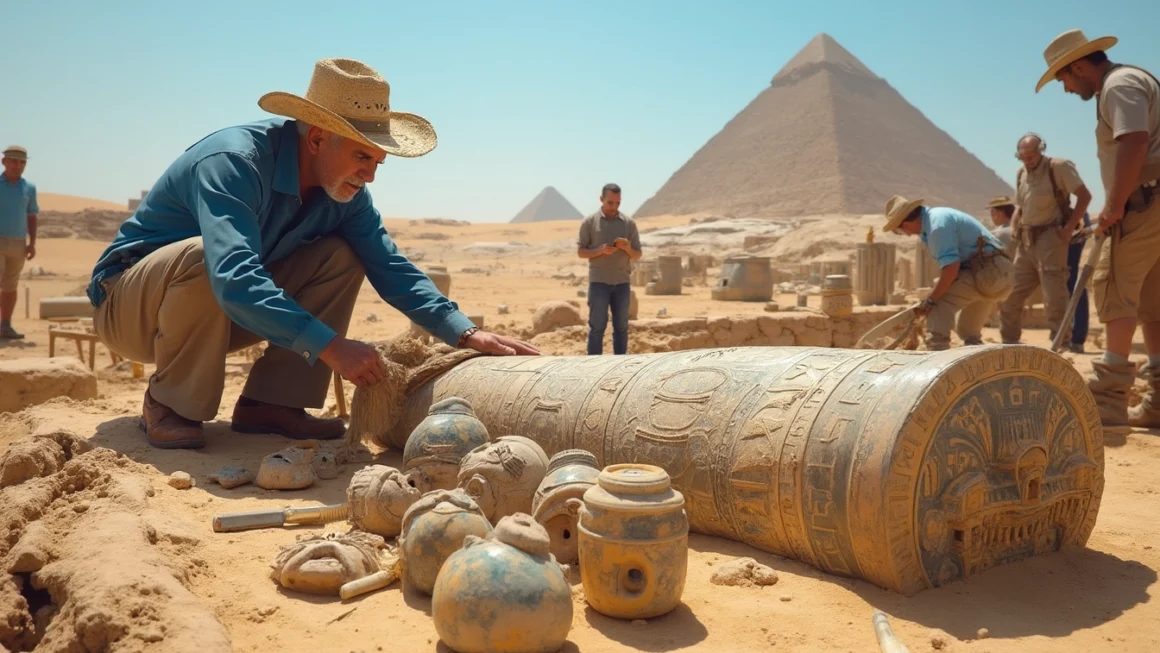Unexpected Discovery in Egypt’s Saqqara Necropolis
Table of Contents
In a remarkable turn of events, archaeologists working in Egypt’s ancient Saqqara necropolis have unearthed a significant find that sheds new light on the region’s rich history. The discovery, made during routine excavations, has excited researchers and history enthusiasts alike.
The Saqqara Necropolis: A Treasure Trove of Ancient Egyptian History
Saqqara, located about 30km (19 miles) south of Cairo, has long been known as a vast burial ground for ancient Egyptian royalty and elite. This latest discovery adds another layer to our understanding of this historically significant site.
Unveiling the Discovery
The excavation team, led by renowned Egyptologist Dr. Zahi Hawass, uncovered a previously unknown tomb dating back to the Old Kingdom period. This era, spanning from about 2686 BC to 2181 BC, is often referred to as the ‘Age of the Pyramids’.
Key Findings:
- A well-preserved sarcophagus adorned with intricate hieroglyphics
- Several ornate funerary masks
- Canopic jars used in the mummification process
- Various items of jewelry and amulets
The Significance of the Discovery
This find is particularly noteworthy for several reasons:
- It provides new insights into burial practices during the Old Kingdom period.
- The quality of preservation offers researchers a unique opportunity to study ancient Egyptian craftsmanship.
- The hieroglyphics found may contain previously unknown historical information.
Dr. Hawass commented, “Each discovery in Saqqara adds a piece to the puzzle of ancient Egyptian civilization. This tomb, with its well-preserved artifacts, is like a time capsule giving us a glimpse into the past.”
Implications for Egyptology
The discovery has significant implications for the field of Egyptology. It not only enhances our understanding of ancient Egyptian burial customs but also provides valuable data for ongoing research into the social and religious practices of the Old Kingdom period.
Researchers are particularly excited about the potential for new historical information that might be gleaned from the hieroglyphic inscriptions. Deciphering these ancient texts could reveal new details about the tomb’s occupant and the historical context of the period.
Preservation and Future Research
The Egyptian Ministry of Antiquities has announced plans for the careful excavation and preservation of the tomb and its contents. The artifacts will be meticulously cataloged and studied before potentially being displayed in one of Egypt’s many world-renowned museums.
This process of preservation and study is crucial for maintaining the integrity of the find and maximizing its research potential. Advanced technological tools will likely be employed in this process, allowing for detailed analysis without risking damage to the delicate artifacts.
The Ongoing Importance of Saqqara
This latest discovery underscores the ongoing importance of Saqqara as an archaeological site. Despite centuries of excavation and study, the necropolis continues to yield new and exciting finds, demonstrating the vast wealth of history still buried beneath the sands of Egypt.
Conclusion: A Window into Ancient Egypt
The unearthing of this tomb in Saqqara is more than just another archaeological discovery; it’s a window into the fascinating world of ancient Egypt. As researchers continue to study the tomb and its contents, we can look forward to gaining even more insights into this remarkable civilization that continues to captivate our imagination thousands of years later.
This find serves as a reminder of the importance of ongoing archaeological work and the potential for new discoveries to reshape our understanding of history. It also highlights the need for continued support and funding for archaeological research, ensuring that we can continue to uncover and preserve these priceless remnants of our shared human heritage.




